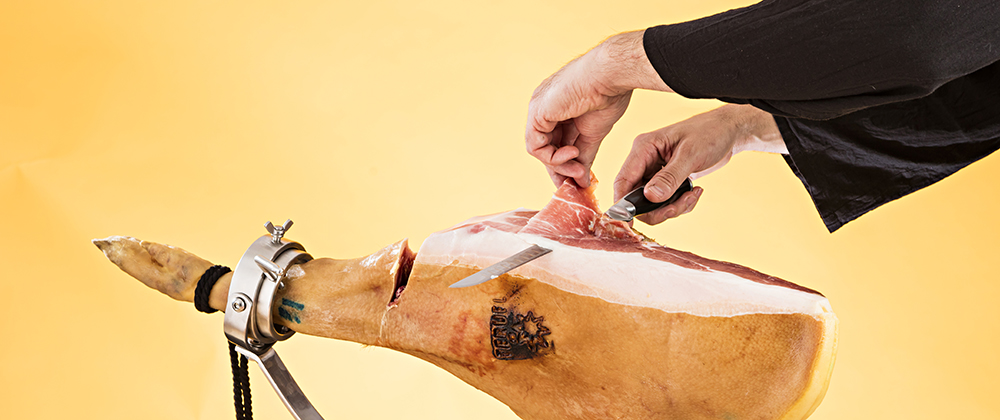Christmas is on its way and with it, hams start appearing in some homes. Many people are not used to having an entire leg in their kitchen and it is usual to take a ham to a butcher to take it off the bone, chop it up and package it in small pieces for better consumption and they might even to slice it up but…. What is best for the ham? Cutting with a knife or a machine?
This debate has people divided although it’s true that within the ham sector, most professionals would choose to cut with a knife. Why? At La Estrella del Jamón we are going to try and explain the pros and cons of each style and therefore help you choose the best method for every occasion.
Cutting with a knife
With a knife, the cut is made in the direction of the muscular fibre, maintaining its natural elasticity and, with it, a firm and consistent texture in the mouth. In addition, the low speed of the knife blade through the meat and the fat and the sideways movement produce a series of fibrillar micro-ruptures that encourage juice and aromas to seep out, keeping them in each slice. This way of cutting ham allows you to taste each and every part of it and thereby appreciate the organoleptic differences of the drumstick, the shank, the knuckle or the tip without mixing flavours. On the other hand, the ritual of this process represents both individual pleasure and a show in itself if you manage to catch a professional ham cutter at any type of event. It is true that if the cutter does not have the necessary skill, some of these advantages can be lost. However, there are many tutorials on the Internet that, with a little practice, will help you improve your technique quickly. Having said that, if you don’t have the right tool, you might be heading for an accident. If we cut our ham with a knife, it is essential to conserve the piece correctly to prevent it from drying out or oxidising too much.
Cutting with a machine
If you have a machine at home, or if you ask your butcher for this type of cutting, it makes the cutting much easier and gives you slices just as thick or thin as you like them. In this way, you can buy smaller pieces of deboned ham and cut it when you like without running the risk of drying out a whole ham. However, an automatic filleting machine usually cuts across the muscular fibres, softening the meat which becomes less firm and affects the texture in the mouth. In addition, due to the speed of the cutting blade, the juices from the ham and part of the fat stay on the machine, affecting the organoleptic qualities of the slice. Another disadvantage, in the case of deboned ham in one piece, it is difficult to appreciate each part of the ham and its different nuances of flavour and aroma.
As manufacturers, we recognise that for us, the effort and dedication that goes into each part is worthy of maximum respect when consuming the product, so personally we’d cut a ham with a knife. This is a process that, in our case, starts around two years before reaching this point, with the salting of the ham. Cutting ham with a knife is an art, albeit at a domestic level, that is accessible to anyone. So, we’d encourage you to learn it and enjoy a recently-cut ham in your own home. If not, you’ll always have the option of a butcher slicing it up just as you like it. Many butchers offer a knife-slicing and packaging service, so you can enjoy your ham whenever and wherever you choose. Whatever you choose, there can be no doubt that ham is gastro-royalty and will always taste great to us.


